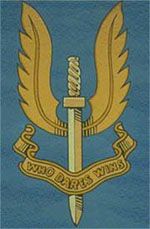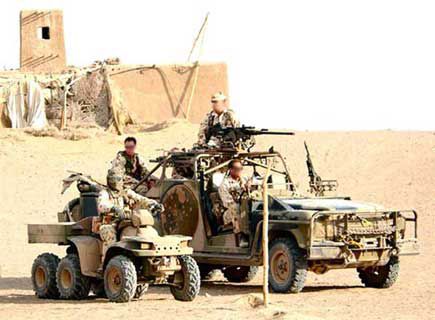

Posted on 08/06/2005 10:45:47 PM PDT by naturalman1975
THE Australian SAS is renowned for the ferocity and discipline of its fighters. As IAN McPHEDRAN explains in this extract from his new book, Afghanistan provided the regiment with one of its greatest challenges
NERVES were taut as two American helicopters descended through pale moonlight into the ancient city of Kandahar for a historic council of war.
Australia's top special forces soldier, Lieutenant Colonel Peter "Gus" Gilmore, the commanding officer of the Special Air Service Regiment, was one of a select group of men on board.
For an hour they had flown low and fast across the barren landscape of southern Afghanistan, away from the coalition forces' forward operating base, "Rhino", towards Kandahar, the country's second biggest city.
The modified Chinook special-operations helicopters had just reached the outskirts of the city when Gilmore heard a loud bang and saw sparks spewing from the back of the machine. He thought they had been hit by ground fire.
"It took me a couple of seconds to realise we were still flying, so of course we weren't hit," Gilmore said later.
It was only a backfire, but it frightened the living daylights out of him and the others on board the blacked-out chopper. Machine-gunners at the rear ramp and side doors anxiously scanned the eerie, softly-lit land below.
United States Marine commander Brigadier-General James Mattis – the commanding officer of Task Force 58, the group formed to secure southern Afghanistan – had invited Gilmore along for his first meeting with anti-Taliban leader Hamid Karzai.
"I'm going to go up tonight to speak with Hamid Karzai in Kandahar about how we will prosecute the plan that we've been putting in place," Mattis had said to Gilmore. "And I'd like you to come with me."
The general had been contemplating how he would occupy Kandahar when a message came through from a US special forces team accompanying Karzai, saying that he would be in town on this night.
Earlier in the campaign the same American team had narrowly escaped annihilation when a misdirected bomb had landed. A number of Americans had been killed and the commander, a lieutenant-colonel, was still deaf in both ears when he met the general's delegation.
"He had seen his sergeant, five feet in front of him, just disappear in a puff of smoke because the bomb had literally landed 20m in front and they'd lost half the team, just like that," Gilmore said.
Mattis, a straight-talking officer in the Marine Corps tradition, had already decided he wanted to enter Kandahar peacefully and be welcomed by the long-suffering locals, rather than going in all guns blazing and risking further civilian losses.
"He knew that they would have to live there and therefore that how you occupy would be critical to the ongoing success of the forward operating base, and, in turn, operations in the south," Gilmore said.
The helicopters touched down at one o'clock in the morning in what appeared to be a park on the outskirts of town.
It was early December 2001, almost three months since Osama bin Laden's al-Qaida terrorist group had flown two planes into the World Trade Centre in New York and a third into the Pentagon, while a fourth, probably on its way to the White House, had crashed in Pennsylvania. More than 3000 people died in the worst terrorist attack in history on September 11, 2001.
On September 20, US President George Bush addressed both houses of Congress and declared the so-called War on Terror. America then unleashed her military might against the Taliban regime of Afghanistan, which was harbouring bin Laden and his al-Qaida fighters.
As the helicopters flew into Kandahar, a city which had been in the hands of allied Northern Alliance forces for just 36 hours, the area around the international airport was still being contested by pockets of Taliban resistance. Two four-wheel-drive vehicles manned by the special forces operators waited to take the Marine commander and his Australian offsider into the city.
Kandahar, Afghanistan's major trading centre, was founded by Alexander the Great in the fourth century BC. The Pashtun city has been fought over every few centuries ever since. It fell to the Islamic fundamentalist Taliban in 1992.
As the vehicles drove quietly through the city's narrow and deserted streets towards the former palace of Taliban leader Mullah Omar, Gilmore thought it was like a scene from a movie. But this was not a Hollywood production and he knew that down any one of the narrow alleys could be someone willing to kill him.
Gus Gilmore had been commanding officer of the SAS since January 2001. An intense and quite formal officer, the father of three is regarded as one of the finest strategic thinkers ever to have worn the sand-coloured beret and winged-dagger badge of the SAS Regiment.
For this mission he was heavily armed, clad in body armour and ready to fight. "There were shady figures in the middle of the night, wearing their black garb, standing around street corners and down little alleys. You're always conscious of the fact that there's a vulnerability, but you get on with it," he said.
Once they reached the palace compound, Gilmore, Mattis and the other American officer on the trip, a US special forces commander, were given a guided tour by a member of Karzai's staff.
They finally entered a gaslit room. There was Karzai with about eight advisers and bodyguards. Also present was Karzai's appointed governor for the region, Sharzai. The floor was covered with beautiful Afghan rugs and cushions and, as they settled down in the traditional surroundings, the modern-day chiefs of war were served pistachio nuts and black tea.
"There was nothing particularly formal about it. It was almost, 'Well, we're here' and the meeting began," Gilmore said.
Karzai welcomed them, telling Mattis that the reputation alone of the US Marines was worth 10,000 men. The cultured and well-educated Afghan then told the group the story of the offensive from the north and the capture of Kandahar.
"He was genuinely pleased to lift the scourge of the Taliban, who had persecuted his people for so long. He was very bitter against the Taliban and clearly optimistic and hopeful of a better life for Afghanis. It was incredibly interesting hearing Hamid Karzai talk as a military commander about how they had just taken Kandahar – his elation, I suppose, plus the fact that things were turning out well for him at the time."
After a while the conversation became less formal and the others began telling their stories. Gilmore was fascinated by the tales of this ragtag army sweeping down from the fabled Northwest Frontier, using taxis and whatever else they could get hold of to carry their fighters.
He was seated next to a bearded warrior in his mid-40s who had skin like leather, a battered face and the toughest hand he had ever shaken. The man, who didn't speak much English, had been liberated from a Taliban prison a few weeks earlier after years in custody and his tales of torture sent a chill down Gilmore's spine.
"Their favourite was to tie them up essentially on a crucifix so that their arms were outstretched and they were standing up," he said.
"Then the guards would stand behind them and just push them forwards so they'd land flat on their face on the ground. They'd do this over and over again."
Women prisoners were tied up and placed in containers, then their feet were beaten with sticks.
"He told me he couldn't get the sound of their screams out of his head."
After about three hours in Kandahar it was time for Gilmore and Mattis to leave the historic meeting and fly back to Rhino.
"In some ways it was quite surreal. Here we were in the middle of the night in Afghanistan, in this town that had been overtaken, sitting in this environment with a gaslit lantern. It was, I suppose, one of the privileges of command to have that exposure early on," Gilmore said.
They left before dawn and arrived at Rhino just as the sun was rising.
Mattis and, subsequently, the head of the Combined Task Force, Major-General John Vines, would use the Australian SAS to conduct very complex tasks. The regiment never faltered, despite working in a situation of extreme mortal danger.
As one seasoned SAS soldier, Warrant Officer Steve, puts it, "We knew for a fact that if you got caught by al-Qaida there, you were toast."
Over that year in Afghanistan, the SAS patrols provided the highest levels of military leadership with some of the most vital intelligence on the movements of al-Qaida and Taliban forces. They discovered detailed terrorist training manuals, the location of former al-Qaida training camps, weapons caches and strategic routes. They also engaged in some of the most deadly encounters and cunning manoeuvres of the War on Terror.
As Mattis himself would write later, "We Marines would happily storm Hell itself with your troops on our right flank."
Taken from The Amazing SAS, by Ian McPhedran, published by HarperCollins on July 27, 2005, rrp $29.95


Book pinger......
Disclaimer: Opinions posted on Free Republic are those of the individual posters and do not necessarily represent the opinion of Free Republic or its management. All materials posted herein are protected by copyright law and the exemption for fair use of copyrighted works.